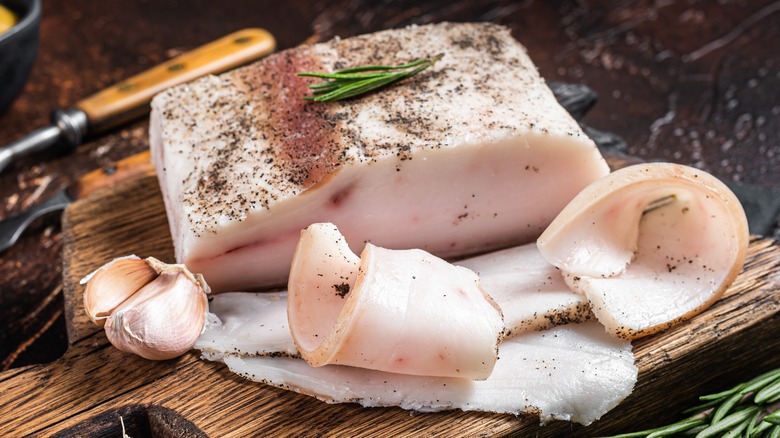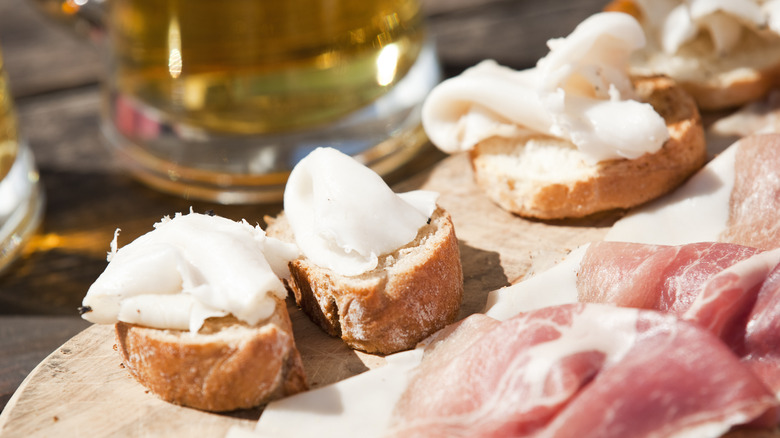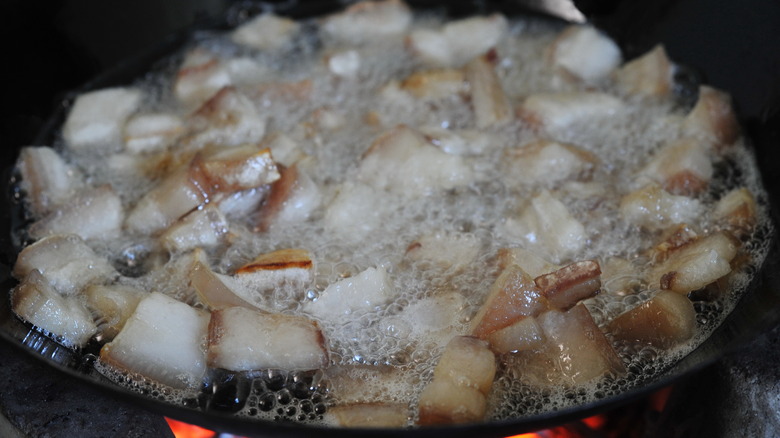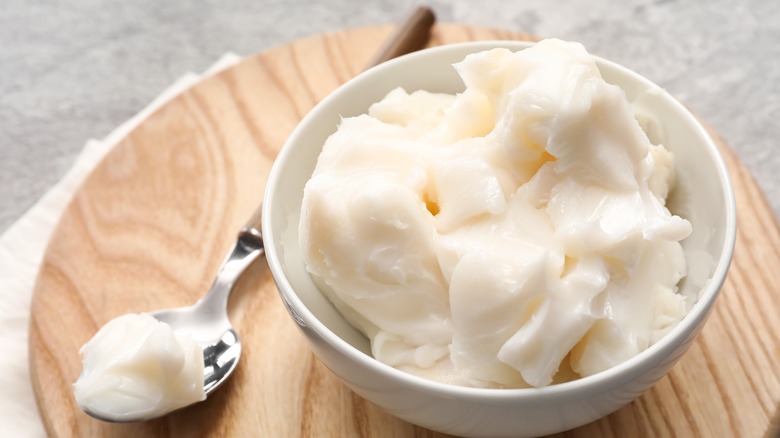Is There Really A Difference Between Lard And Lardo?
Lard and lardo are just one letter apart, but these two foods are actually rather different in how they are made, what they are used for, and what they taste like. Both products have a base of pork fat, but the similarities pretty much end there. To make lard, a fatty piece of pork or a slab of pure pork fat is cooked low and slow, until all the fat melts out and liquifies – this process is called rendering. Once the fat has been rendered, it is then filtered and chilled, which causes the lard to firm up into a solid, off-white block. It's nothing but pure, rendered fat that can be used in both cooking and baking.
Lardo, on the other hand, is an Italian product made by salt-curing an large, intact piece of pork fat from the back of the pig. It's often seasoned, as well, and usually eaten with various accompaniments, though you can also cook with it.
Think of lard as a cooking fat that can be used in place of butter, shortening, oil, or even the best bacon grease substitute you can use. Lardo is a type of salumi — the Italian equivalent of French charcuterie. It should be enjoyed as-is in simple dishes, so you can appreciate the silky texture and rich flavors of the cured fat. As an aside, lardo should not be confused with lardons, which are matchstick-like pieces of pork belly products such as bacon.
Lardo is the appetizer you didn't know you needed
A slice of fat may not sound like the most appealing bite of food to everyone, but have some faith that the Italians know what they are doing. To make lardo, a slab of fat is coated in salt, herbs, and spices and left to cure for six to 18 months. During that time, the fat takes on all the flavors from the ingredients, which may include garlic, oregano, rosemary, sage, coriander, anise, cinnamon, thyme, black pepper, and/or juniper berries. The salt extracts moisture during the long curing process, and the fat's texture transforms from greasy to buttery and smooth.
Enjoy lardo alongside a spread of other delicious Italian salumi, such as mortadella, coppa, prosciutto, and speck, alongside fried dough or toasted bread. Lardo should be served in very thin slices so that it melts slightly on top of warm bread or crackers. Unlike more assertively salty and meaty cured products, pair lardo with simple flavors so its nuance are not overpowered by strong condiments or pickles. Honey, apricots, and figs play up the subtle sweetness of the fat without overwhelming it.
You can also toss lardo into salads, or use it as a garnish on pasta or roasted vegetables. You can use lardo in cooking, but many experts recommend that you avoid cooking it, as you will lose the texture and subtlety of this decadent product.
Different types of lard
Rendered lard can be made at home, but is also sold in jars or tubs. For the best quality, look for lard that does not have any added ingredients. Processed lard usually goes through a process called hydrogenation so it stays solid at room temperature. These products may also include emulsifiers, bleach, or deodorizers, all of which get rid of the porky taste and produce a whiter color. This is just fine for recipes like a pie crust, but lard's meaty flavor is what makes it worth using in savory applications.
Both rendered and processed lard start with unrendered lard, otherwise known as pork fat. You can buy a plain piece of fat from a butcher shop and cook it down to make lard yourself, saving money and giving you a better flavor for use in soups, stews, savory pastries, French fries, and anything else that benefits from some porky richness.
The crème de la crème of lard is leaf lard. It comes from a pocket of fat that surrounds the pig's kidneys. This fat is more delicate and creamy than the fat rendered from other types of pig fat, and it does not have a strong porky flavor. Leaf lard is a go-to choice for bakers, because it easily forms super-flaky layers in pie crusts and biscuit doughs. There's only so much leaf lard on each pig, which makes it even more valuable.
The misunderstood nutrition of lard
Many cooks avoid using lard due to its reputation as an unhealthy fat, but this isn't really true. So long as you buy the right kind and use it in moderation, lard is nutritionally comparable to many other cooking fats. The best-quality lard is made up of 100% pure pork fat. Cheaper lard that has been hydrogenated and stays fully solid when at room temperature contains trans fats. Natural trans fats, like those found in animal products, are much less potentially harmful than artificial trans fats, but they still should not be consumed in excess.
Interestingly, pure lard actually has a lower percentage of saturated fat than butter does. Despite it being an animal product, lard is likely a healthier choice than something like partially hydrogenated vegetable oils, often called shortening. Of course, lard remains a less nutritious option than omega-3 rich, unsaturated olive oil, but unprocessed lard does contain a significant amount of heart-healthy, monounsaturated fats.
All cooking fats should be used sparingly, and fat itself is an essential part of a healthy diet. In the wide spectrum of options, lard (and lardo!) falls somewhere in the middle when it comes to the "healthiest" fat you can consume. It can absolutely be part of a well-balanced diet, and is certainly not the pariah that some nutritionists once considered it to be.




